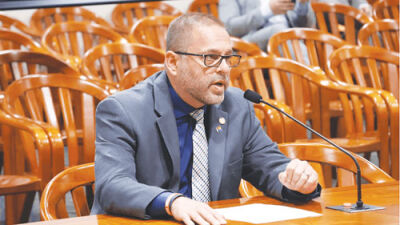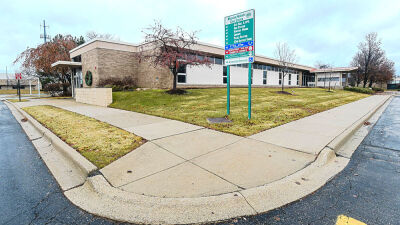WEST BLOOMFIELD — The West Bloomfield Township Board of Trustees is expected to vote June 23 on a possible water and sewer rate hike that will start with the July 1 meter read.
Brian Camiller, a certified public accountant with Plante Moran, presented a water and sewer study at the June 2 board meeting. He described three options for rate increases to help meet inflationary costs. Board members then requested a special work session for June 10.
At the special work session, trustees directed questions to Camiller and the township’s water and sewer utilities director, Justin Taylor. Other department heads were also present.
A rate hike is being considered due to higher costs incurred by inflation, as well as the number of construction projects being planned, including infrastructure repairs. Water loss and declining usage are also factors, Camiller explained.
For the last 10 years, rate increases through the Great Lakes Water Authority were held at 4% per year. Today, the rate increase is 6%, and there is no limit on how high it will go, he said.
Inflation has increased the cost of the West Acre capital investment water main replacement project. Five years ago, it was estimated at $11.4 million. Today, the cost estimate is $14.4 million. Taylor said the water mains in this subdivision are more than 100 years old and in need of replacement.
Water loss is another factor. Water loss is defined as any water that is not metered, according to Nick Kutsoginis, the township superintendent for water and sewer.
“Our water loss is actually pretty low compared to most communities around here,” Kutsoginis said.
For many years, the township had a water loss rate of 3% or less. Camiller said that the rate of loss has increased to 11% the past four years.
The township is currently undergoing a meter change-out program to fix any of the old meters that might not register the water.
“We are doing an acoustical sound detection around the whole community. We have a company checking all the water mains to make sure there are no leaks,” Kutsoginis said. “If we can find any leaks, we’re going to address those immediately.”
Water usage is also declining. In 2016, there were 293,000 units of water sold. In 2024, water units decreased by 50,000 units to 243,000 units, Camiller said — a decrease of about 17%, which means the township needs a greater margin per unit sold to cover costs.
“Even your toilet nowadays is high efficiency and they’re using a lot less water,” said Kutsoginis. “Everything out in the world nowadays uses a lot less water. Even people are using way less water. It’s just a thing of the future.”
The report by Plante Moran noted that current rates don’t generate enough revenue to top off townships reserves. Officials say the water rate has not been raised in many years.
“The goal is to get the systems back on track as soon as possible and return to what is somewhat near an inflationary increase in future years,” Camiller said.
He explained how the township and other communities started falling behind.
“Costs have exceeded earlier expectations,” Camiller said. “Municipalities have not been raising rates at an appropriate level in order to maintain their infrastructure and handle the cost increases.”
To rectify this, three models were proposed: “Steady Eddie,” “Rip the Band-Aid Off,” and “Slower Band-Aid Pull.”
“Steady Eddie” is a rate hike of about 10% each year for the next five years, alongside a sewer rate increase of about 7% each year for five years.
“Rip the Band-Aid Off” starts with the highest rate increase — 23% the first year — followed by four years of a 4% increase. The sewer rates would increase 13% the first year and then 4% each year for four years.
“Slower Band-Aid Pull” starts with a first-year increase of about 18% followed by 6% increases each year for four years. The sewer rates would be at an 18% increase the first year and then dip to a nearly 2% increase for each year for four years.
Whichever model is chosen will be reevaluated annually with the help of Plante Moran.
“A five-year model is not a five-year commitment,” Camiller said.
He explained that the projections may look different after a year or two, and that they may need to be adjusted upwards or downwards to meet the township’s goals.
Because there are no guarantees and the numbers can change from one year to the next, board trustee Michael Patton inquired about the effects of implementing the rate hike all at once versus spreading it over a five-year period.
Camiller said his experience with other communities leads him to recommend the “Rip the Band-Aid Off” model.
“You just have to do one hard decision now. … Getting 4% in future years, that seems like a much easier discussion, and the 23% upfront gets you on the right track almost instantly,” Camiller said. “It is the fastest way to achieve the ultimate goal, and at the end of five years … that rate results in the lowest rate at that point in time.”
He said that the goal is to have enough cash to pay bills and have sufficient reserves. Camiller is currently working with other communities facing the same balancing act.
“The majority of them are ending up with some version of ‘Rip the Band-Aid Off.’ That initial big rate increase is different in each place. It is as low as 12% in one Oakland County city. … It is as high as 49% in total in a Wayne County city,” Camiller said.
The vote becomes effective with the July 1 meter reads, with the bill coming out at the end of July, according to Taylor. The water bills are issued quarterly. A third of West Bloomfield water customers receive a water meter reading each month.
“I think a letter should go out to the residents that their rates will be going up, so they can take appropriate measures to pay their bill,” said Diane Rosenfeld Swimmer, a board trustee.
Teri Weingarden, a board trustee who also serves as the township’s treasurer, said that a mailing would cost upward of $12,000. She said the information could be posted on social media and included in residents’ water bills instead.
Debbie Binder, a trustee and the township clerk, referred to the rate hike decision as “not fun” and a “hard pill to swallow,” but she said that “sometimes, providing responsible leadership means making tough decisions.”
Jim Manna, another board trustee, was in favor of the “Steady Eddie” approach to increasing water bills and suggested going to a monthly bill rather than the current quarterly bill, as well as offering vouchers for payment assistance.
“We need to help people that are suffering and can’t pay their water bill,” Manna said at the work session.
According to its website, the Great Lakes Water Authority offers water bill assistance through various community partners. They encourage water customers to apply for assistance before their water is shut off.
For more information, call United Way Southeastern Michigan at (844) 211-4994.
 Publication select ▼
Publication select ▼






















